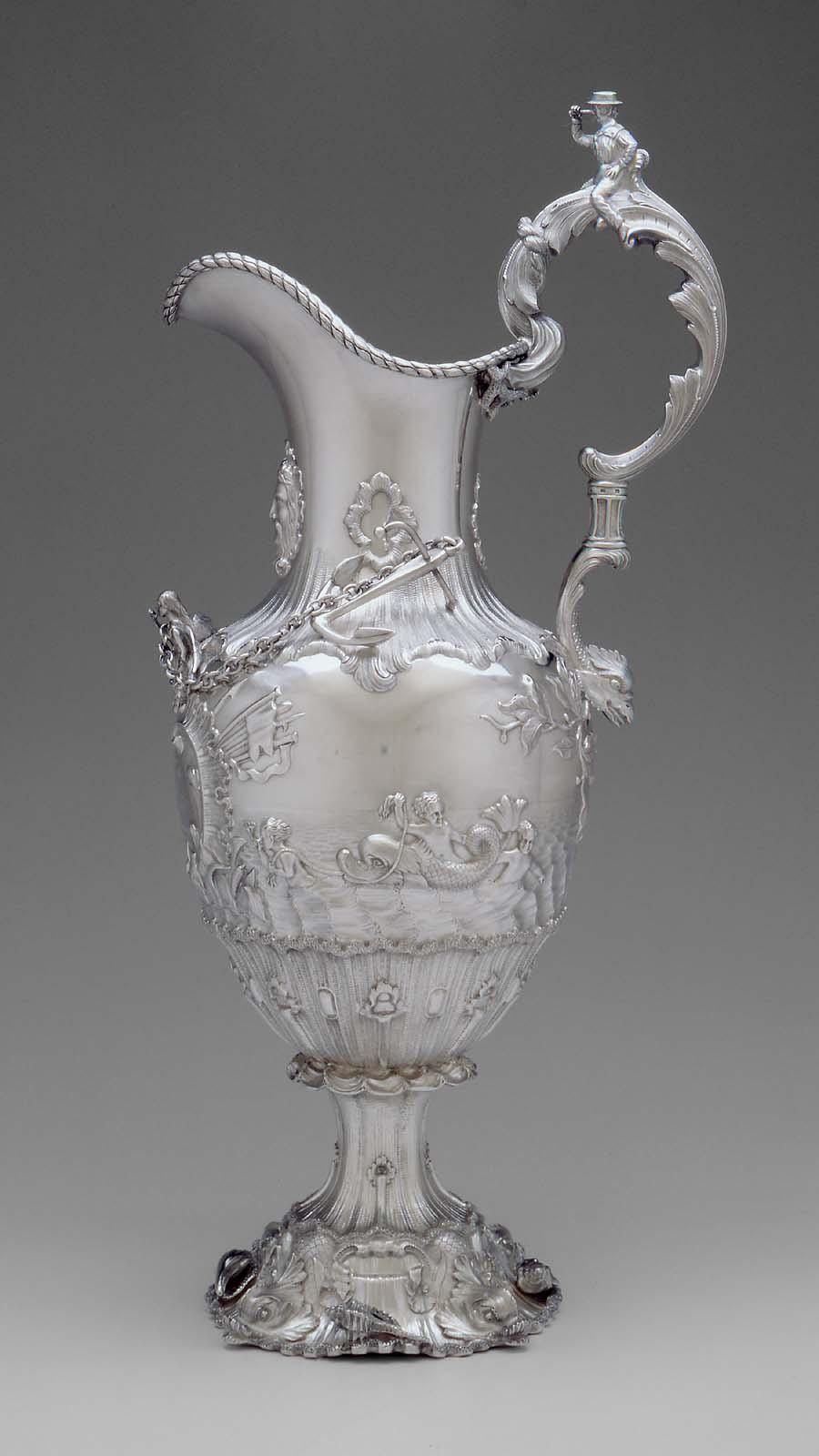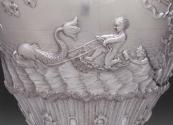Advanced Search
Ewer
Eoff and Shepard (American, 1852–1861)
Edgar Mortimer Eoff (active about 1844–1861)
George L. Shepard (active about 1852–1862)
Retailed by: Ball, Black & Co (American, 1852–1874)
Edgar Mortimer Eoff (active about 1844–1861)
George L. Shepard (active about 1852–1862)
Retailed by: Ball, Black & Co (American, 1852–1874)
about 1860
Object Place: New York, New York, United States
Medium/Technique
Silver
Dimensions
49.5 x 24 x 19 cm (19 1/2 x 9 7/16 x 7 1/2 in.)
Credit Line
Helen and Alice Colburn Fund
Accession Number1977.620
NOT ON VIEW
CollectionsAmericas
ClassificationsSilver hollowware
Edgar Mortimer Eoff and George L. Shepard operated a modern steam-powered silverware manufactory that employed twenty-five workers. For nearly a decade, the firm supplied distinctive silverware to prestigious luxury-goods retailers such as Ball, Black & Co. According to its marks and inscriptions, this extraordinary ewer was exhibited by Ball, Black & Co. at New York’s 1864 Metropolitan Fair, where it was purchased by Bostonian John Williams Quincy. The fair was one of a series held in the northern states to benefit the U.S. Sanitary Commission and its efforts to support hospitals and medical relief during the Civil War. The ewer may have been exhibited at the “Museum of Arms and Trophies for Exhibition and Sale” held at the fair. The engravings were probably added by Quincy to honor the wishes of his late mother.
Bedecked with sea nymphs, dolphins, conch shells, and swirling waves, this tall, classically shaped domestic vessel has been cast in the role of an ocean-going ship. On the prow, under Neptune’s vigilant eye, an angel figurehead thrusts forward above the breakwater. Three-dimensional anchors with draped chains complete the fantasy prow. Symbols of Christian faith, the angel and the anchors combine with nautical elements to create an impressive memorial to Captain Atkins.
This text has been adapted from "Silver of the Americas, 1600-2000," edited by Jeannine Falino and Gerald W.R. Ward, published in 2008 by the MFA. Complete references can be found in that publication.
Bedecked with sea nymphs, dolphins, conch shells, and swirling waves, this tall, classically shaped domestic vessel has been cast in the role of an ocean-going ship. On the prow, under Neptune’s vigilant eye, an angel figurehead thrusts forward above the breakwater. Three-dimensional anchors with draped chains complete the fantasy prow. Symbols of Christian faith, the angel and the anchors combine with nautical elements to create an impressive memorial to Captain Atkins.
This text has been adapted from "Silver of the Americas, 1600-2000," edited by Jeannine Falino and Gerald W.R. Ward, published in 2008 by the MFA. Complete references can be found in that publication.
DescriptionThe raised body of the pitcher is an inverted pear-shape with a long tapered neck and high drawn spout. There is a large cast double-curved handle and raised, splayed foot. Applied rope-like beading extends around the spout's outer edge. A ringlet of "waves" at the top of the base cradles the body of the "vessel" as a ripple of frothy tide on the shoulder articulates the passage from body to neck. Applied 3-dimensional anchors ride at either side of the shoulder with their chain held up by a cast and applied female figure at the front. An engraved panel in front is surrounded by a repousséd and chased cartouche of watery scrolls couched in a patch of cattails. It is flanked by vignettes of sea nymphs and dolphins on the sides of the vessel with oak branches toward the back near the joining of the handle. The lower portion of the body and stem of the foot are ribbed in imitation of waves with alternating applied oval and leafy rosettes. The rim of the flared foot is alive with repousséd and chased aquatic and vegetal motifs and alternating cast and applied dolphin heads and seashells. The double C-scroll handle is joined to the body just under the lip with applied coral-like fronds. Its larger top section is simulates cresting waves and is surmounted by a cast and applied sailor figure. In the lower section, a small scroll terminates in a dolphin's head attached to the body at the shoulder.
Marks
"E. & S" stamped in a rectangle, "BALL, BLACK & CO" in semi-circular band, "N. YORK" in rectangle, "162" and "950"
InscriptionsEngraved in script on the side of the neck "New York April 18th 1864 / Purchased by John W. Quincy at the great / Metropolitan Fair." Engraved on front "In Memorium. / This token of respect and affection to the memory of Captain Silas Atkins of Boston, Mass. / (Who died Dec. 7th. 1835. Aged 88 years) / is inscribed at the request of his daughter, / Abigail Atkins Quincy. / (Who died at Dorchester, Mass. Aug. 24th 1861. Aged 89 years. / to perpetuate his name and memory as a faithful husband, / and an affectionate father. / He pursued Navigation and Commerce, / and early retired to enjoy the reward / of his industry."
ProvenanceTo honor his mother’s request for a memorial to her father, Capt. Silas Atkins (1747 – 1835), the ewer was purchased by Bostonian John W. Quincy (1813 – 1883) at the 1864 Metropolitan Fair in New York City. Its subsequent history is unknown until purchased by the museum in 1977 from Thurston H. Smith Jr. of Locust Valley, New York.









